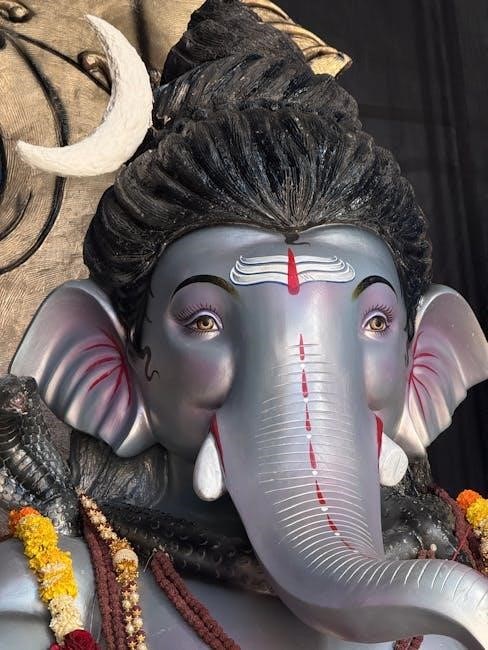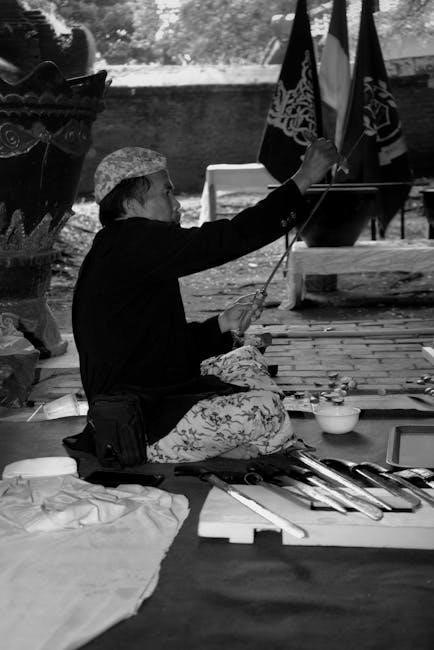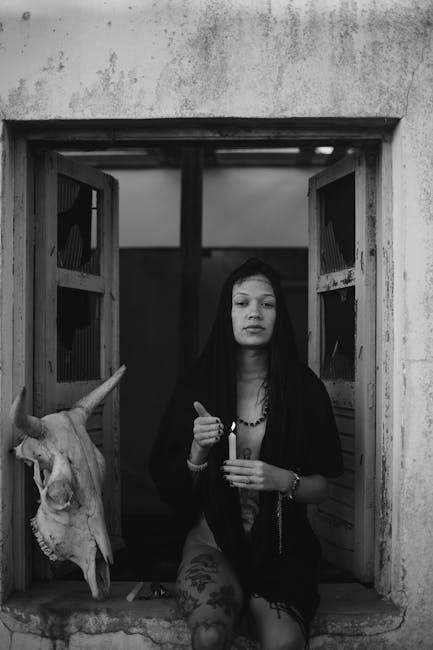
mystical passion spirituality and sensuality pdf
Mystical passion‚ spirituality‚ and sensuality intertwine as profound human experiences‚ exploring the sacred‚ emotional depth‚ and transcendence․ This introduction delves into their interconnectedness and transformative power․
These concepts have been historically explored in philosophy‚ religion‚ and psychology‚ offering insights into human longing for meaning and connection․ Sensuality often serves as a bridge between the physical and spiritual realms‚ fostering mystical experiences․
1․1․ Defining the Core Concepts
Mystical passion refers to intense emotional or spiritual connections‚ often transcending the physical․ Spirituality is broadly defined as a search for the sacred‚ encompassing personal growth and meaning․ Sensuality‚ while often linked to physical experiences‚ also bridges the gap between material and mystical realms․ Together‚ these concepts explore the interplay of emotion‚ transcendence‚ and human connection‚ forming a foundation for understanding their roles in personal and collective awakening․
1․2․ The Intersection of Mysticism and Sensuality
Mysticism and sensuality converge in experiences that transcend the physical‚ blending spiritual longing with sensory exploration․ Mach views reality as a flow of impressions‚ suggesting sensuality as a gateway to mystical awareness․ This intersection highlights how intimate‚ sensory experiences can evoke profound spiritual connections‚ revealing the body as a vessel for transcendence and unity with the divine․
1․3․ Spirituality as a Search for the Sacred
Spirituality is a profound quest for the sacred‚ often described as a broad and inclusive search for meaning and transcendence․ It encompasses personal reflection‚ emotional depth‚ and a connection to something greater than oneself․ This journey can manifest through various practices‚ fostering healing and self-discovery․ Spirituality’s universal appeal lies in its ability to transcend cultural boundaries‚ offering a pathway to inner harmony and enlightenment․

Mystical Passion and Spiritual Awakening
Mystical passion ignites a profound journey towards spiritual awakening‚ fostering deep introspection‚ unity with the divine‚ and a transformative experience that awakens higher consciousness․
2․1․ The Role of Passion in Mystical Experiences
Passion plays a pivotal role in mystical experiences‚ serving as a bridge between physical and metaphysical realms․ It ignites intense emotional and spiritual connections‚ often leading to transcendence and unity with the divine․ Mystics throughout history have described passion as a driving force that dissolves ego boundaries‚ fostering profound spiritual awareness․ This intense energy becomes a catalyst for inner transformation‚ guiding individuals toward deeper states of consciousness and enlightenment․ Passion is thus essential in the pursuit of mystical union․
2․2․ Spiritual Awakening Through Sensuality
Sensuality serves as a powerful gateway to spiritual awakening by engaging the body and emotions in the pursuit of the divine․ Through intimate connections and sensory experiences‚ individuals can transcend material boundaries‚ fostering a deeper union with the universe․ Sensuality awakens consciousness‚ allowing practitioners to embrace their humanity while seeking sacred truths․ This holistic approach harmonizes physical and spiritual dimensions‚ facilitating profound inner transformation and enlightenment․
2․3․ Historical Examples of Mystical Passion
Throughout history‚ mystical passion has been expressed through profound spiritual and sensual experiences․ Figures like Rumi and St․ Teresa of Ávila exemplify how intense emotional and spiritual longing can lead to divine union․ Their writings and practices highlight the transformative power of passion‚ blending human desire with sacred devotion․ These historical accounts illustrate how mystical passion has been a universal language for connecting with the divine across cultures and timelines․

Sensuality and Spirituality in Religious Traditions
Sensuality and spirituality intertwine in various religious traditions‚ where the human body is often seen as a vessel for divine connection and sacred expression․
3․1․ Sacred Sensuality in Eastern Religions
In Eastern religions‚ sensuality is often revered as a sacred path to spiritual awakening․ Hinduism’s Tantra and Buddhism’s Vajrayana traditions embrace sensual practices as a means to transcend the physical and unite with the divine․ The Kama Sutra and rituals like Maithuna illustrate how pleasure and intimacy are harnessed for spiritual growth‚ blurring the line between the earthly and the eternal․ These practices emphasize harmony and consciousness‚ not mere indulgence․
3․2․ The Role of Passion in Christian Mysticism
Christian mysticism often views passion as a powerful force for spiritual devotion and union with God․ Mystics like St․ Teresa of Ávila and St․ John of the Cross describe intense emotional and physical experiences as expressions of divine love․ Passion‚ in this context‚ transcends earthly desire‚ becoming a sacred longing for intimacy with the divine․ It fuels devotion‚ prayer‚ and self-surrender‚ guiding believers toward a deeper connection with God’s will and love․
3․3․ Sensuality and Spirituality in Indigenous Cultures
Indigenous cultures often blend sensuality and spirituality seamlessly‚ viewing the body as a sacred vessel for the divine․ Rituals‚ dances‚ and ceremonies frequently incorporate sensual elements to connect with nature and ancestral spirits․ This holistic approach honors the interconnectedness of physical and spiritual realms‚ celebrating life’s cycles and the beauty of human experience as a reflection of sacred harmony and balance․

The Psychology of Mystical Experiences
Mystical experiences profoundly impact human consciousness‚ revealing altered states‚ integrated self-universe perceptions‚ and heightened emotional-cognitive responses like awe‚ joy‚ and transcendence․
4․1․ The Phenomenology of Mystical Experiences
Mystical experiences often involve profound feelings of unity with the universe‚ timelessness‚ and spacelessness‚ alongside heightened emotional states like joy‚ awe‚ and insight․ Phenomenologically‚ these experiences are characterized by a dissolution of the self-other dichotomy‚ leading to a sense of interconnectedness․ They frequently evoke transformative changes in perception‚ offering new meanings and purposes․ Such experiences are deeply personal and subjective‚ yet universally meaningful‚ often intertwining spirituality with sensuality and passion‚ creating a holistic sense of being and connection to existence․
4․2․ The Role of Sensuality in Psychological Healing
Sensuality plays a vital role in psychological healing by fostering emotional and physical well-being․ It encourages self-care‚ intimacy‚ and connection‚ which can reduce stress and anxiety․ Through mindful touch and intimate experiences‚ individuals can reconnect with their bodies‚ promoting a sense of safety and empowerment․ This mind-body harmony often leads to emotional resilience‚ enhancing overall mental health and spiritual growth‚ while nurturing a positive relationship with one’s physical form and desires․
4․3․ Passion as a Catalyst for Spiritual Growth
Passion serves as a powerful catalyst for spiritual growth by igniting deep emotional and existential exploration․ It propels individuals beyond superficial existence‚ fostering a quest for meaning and connection to the divine․ Through intense emotional experiences‚ passion often triggers introspection‚ self-awareness‚ and transcendence․ This inner transformation can lead to profound spiritual awakening‚ guiding individuals toward higher states of consciousness and a deeper understanding of their purpose and place in the universe‚ enriching their spiritual journey․

Cultural and Historical Perspectives
Cultural and historical contexts reveal diverse interpretations of mystical passion‚ spirituality‚ and sensuality․ Across civilizations‚ these elements have been intertwined‚ reflecting evolving societal values and beliefs about human connection and transcendence․
5․1․ Mystical Passion in Art and Literature
Art and literature have long been vessels for expressing mystical passion‚ blending spirituality and sensuality․ From Rumi’s poetic devotion to the divine to iconic paintings like Bernini’s “Ecstasy of Saint Teresa‚” these works capture transcendent experiences through sensual forms․ Such creations reflect the eternal dance between human emotion and the sacred‚ inspiring introspection and connection to deeper truths across centuries and cultures‚ embodying the essence of mystical passion;
5․2․ The Evolution of Spiritual and Sensual Practices
Spiritual and sensual practices have evolved significantly across cultures and eras‚ reflecting shifting societal norms and philosophical understandings․ Ancient rituals often intertwined physical and metaphysical experiences‚ while later traditions sought to separate or reconcile these aspects․ Modern practices blend elements from diverse heritages‚ emphasizing holistic approaches to spirituality and sensuality․ This evolution highlights humanity’s enduring quest to harmonize bodily and transcendent experiences‚ fostering deeper self-awareness and connection to the divine․
5․3․ The Impact of Cultural Norms on Mystical Experiences
Cultural norms profoundly influence how mystical experiences are perceived and expressed․ In some traditions‚ sensuality is celebrated as a pathway to the divine‚ while others may suppress it‚ viewing it as contradictory to spirituality․ These norms shape interpretations of mystical encounters‚ often reflecting societal values․ For instance‚ certain indigenous cultures integrate physical expression into sacred rituals‚ whereas some religious traditions emphasize asceticism․ This diversity highlights the interplay between culture and mysticism․

Practical Applications of Mystical Passion and Spirituality
Practical applications of mystical passion and spirituality include meditation‚ sensual awareness‚ and integrating these practices into daily life for sustained spiritual growth and harmony․
6․1․ Meditation and Sensual Awareness
Meditation and sensual awareness practices harmonize the body and spirit‚ fostering profound connection․ Techniques like breath focus‚ sensory exploration‚ and mindful presence cultivate intimacy with oneself and the divine․ By embracing both stillness and sensation‚ individuals can transcend duality‚ integrating pleasure and spirituality for holistic well-being and deeper connection to the sacred․
6․2․ Rituals and Practices for Spiritual Awakening
Rituals and practices‚ such as chanting‚ dance‚ or sensory deprivation‚ create pathways to spiritual awakening․ These exercises quiet the mind‚ allowing individuals to connect with the divine․ By transcending the physical‚ practitioners experience oneness‚ fostering profound mystical insights and emotional depth․ Such practices bridge the gap between the earthly and the sacred‚ enabling a deeper understanding of the self and the universe․
6․3․ Integrating Mystical Passion into Daily Life
Integrating mystical passion into daily life involves embracing mindfulness‚ meditation‚ and embodiment practices․ By infusing sensuality into routines—like savoring meals or engaging in intimate connections—individuals can deepen their spiritual awareness․ Rituals‚ such as journaling or creating art‚ also help channel passion into meaningful expression․ This holistic approach fosters a seamless blend of spirituality and sensuality‚ enriching everyday experiences with profound purpose and connection․

The Role of Love and Heritage in Mystical Experiences
Love and heritage deeply influence mystical experiences‚ serving as bridges between personal and universal consciousness․ Cultural traditions and ancestral wisdom often illuminate spiritual paths‚ fostering connection and transcendence․
7․1․ Love as a Mystical Force
Love serves as a profound mystical force‚ transcending physical boundaries and uniting individuals with the divine․ It embodies the essence of connection‚ fostering spiritual awakening and deeper consciousness․ Through love‚ the self dissolves into universal oneness‚ revealing the sacred within all existence․ Mystical traditions often depict love as a transformative energy‚ guiding seekers toward enlightenment and harmony with the cosmos․
7․2․ The Influence of Cultural Heritage on Spirituality
Cultural heritage profoundly shapes spiritual practices‚ offering a lens through which individuals connect with the divine․ Rituals‚ symbols‚ and stories passed down through generations provide meaning and structure to spiritual journeys․ Indigenous traditions often emphasize harmony with nature‚ while Eastern philosophies like Buddhism and Taoism focus on introspection and balance․ These cultural frameworks guide seekers in understanding mystical experiences and integrating them into daily life‚ fostering a sense of belonging and continuity․ Heritage thus enriches spirituality‚ making it deeply personal and rooted in shared human history․
7․3․ Balancing Passion and Spirituality in Modern Life
Modern life often presents a challenge in harmonizing passion and spirituality․ By embracing mindfulness and intention‚ individuals can integrate these forces․ Setting boundaries while allowing passion to inspire spiritual growth fosters balance․ This synergy enables a life where sensuality and sacredness coexist‚ reflecting the interconnectedness of human experience and promoting emotional and spiritual well-being in a contemporary context․

The Connection Between Mysticism and Consensual Practices
Mysticism and consensual practices share a foundation of trust‚ communication‚ and mutual respect‚ creating a sacred space for transformative experiences that honor both spirituality and sensuality․
8․1․ Rituals and Practices in Consensual SM
Consensual SM practices often involve structured rituals that emphasize power dynamics‚ trust‚ and communication․ These rituals can mirror mystical experiences‚ fostering a deep emotional and spiritual connection․ Techniques like meditation‚ breathwork‚ and symbolic acts are used to create a sacred space‚ blending sensuality with spiritual intention․ The focus on consent and mutual respect ensures a transformative experience‚ aligning with the principles of mystical passion and spiritual growth․
8․2․ Parallels Between Mystical and Ritualistic Practices
Mystical and ritualistic practices share a common thread in their use of structured ceremonies to create sacred spaces․ Both often involve symbolic acts‚ sensory stimulation‚ and a focus on intentionality to heighten awareness and foster connection․ Whether through meditation‚ chanting‚ or consensual SM rituals‚ these practices aim to transcend the mundane‚ creating a profound sense of unity and spiritual or interpersonal resonance․
8․3․ The Role of Sensuality in Modern Spiritual Movements
Modern spiritual movements increasingly embrace sensuality as a pathway to deeper connection and enlightenment․ Practices like tantra-inspired workshops encourage individuals to integrate physical and spiritual experiences‚ fostering presence and intimacy․ By honoring the body as sacred‚ these movements promote healing and empowerment‚ blending sensuality with spiritual pursuit to create holistic experiences of worship‚ self-discovery‚ and spiritual evolution‚

The Emerging Worldview of Oneness and Cooperation
The emerging worldview emphasizes interconnectedness‚ fostering unity and cooperation․ It integrates spiritual awakening with collective harmony‚ promoting a culture of oneness and mutual support for global transformation․
9․1․ Biomimicry and the Connection to Spirituality
Biomimicry‚ the practice of emulating nature’s patterns‚ reveals profound spiritual connections․ By studying natural designs‚ we uncover rhythms and harmonies that mirror divine order‚ fostering a deeper sense of oneness․ This approach inspires mystical passion‚ as it bridges the physical and spiritual realms‚ encouraging humans to align with nature’s wisdom for sustainable and sacred living․
9․2․ The Role of Inner Net of the Heart in Mystical Experiences
The “Inner Net of the Heart” symbolizes the intricate web of emotions and intuition‚ serving as a bridge between the self and the divine․ It facilitates profound connections‚ enabling individuals to experience unity and transcendence․ By nurturing this inner network‚ one can deepen mystical experiences‚ integrating passion with spirituality for a richer sense of oneness and enlightenment․
9․3․ Cooperation as a Path to Spiritual Awakening
Cooperation fosters unity and shared purpose‚ becoming a powerful catalyst for spiritual awakening․ By working together‚ individuals transcend ego-driven barriers‚ embracing collective consciousness․ This collaborative approach mirrors the interconnectedness of all beings‚ deepening mystical experiences and fostering empathy․ Cooperation‚ rooted in mutual respect‚ becomes a sacred practice‚ guiding individuals toward enlightenment and oneness with the universe․
Mystical passion‚ spirituality‚ and sensuality intertwine‚ offering profound paths to self-discovery and enlightenment․ Their integration fosters holistic growth‚ bridging the physical and divine for transformative living․
10․1․ The Interplay of Mystical Passion‚ Spirituality‚ and Sensuality
Mystical passion‚ spirituality‚ and sensuality form a dynamic interplay‚ enriching self-discovery and enlightenment․ Passion ignites the soul‚ spirituality guides the journey‚ and sensuality grounds the experience in the body․ Together‚ they create a harmonious dance‚ fostering deep connection and unity․ This integration transcends duality‚ revealing the sacred in both the physical and metaphysical realms‚ and invites individuals to embrace their wholeness in the pursuit of transcendence and awakening․
10․2․ The Future of Mystical and Spiritual Practices
The future of mystical and spiritual practices will likely involve a deeper integration of technology‚ accessibility‚ and inclusivity․ As global consciousness evolves‚ practices may emphasize sustainability‚ holistic well-being‚ and interconnectedness․ The rise of digital platforms will make spiritual tools more accessible‚ while traditional methods will adapt to modern needs‚ ensuring that mystical passion and sensuality remain vibrant pathways to enlightenment and personal transformation․

10․3․ Final Thoughts on the Integration of Passion and Spirituality
The integration of passion and spirituality offers a profound path to wholeness‚ blending the intensity of human emotion with the transcendence of the divine․ This union fosters personal and collective transformation‚ encouraging individuals to embrace their full potential․ By harmonizing these forces‚ we cultivate fulfillment‚ inner harmony‚ and a deeper connection to life․ This synergy serves as a guiding force for a balanced and meaningful existence․
Comments (0)